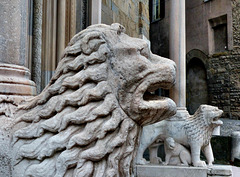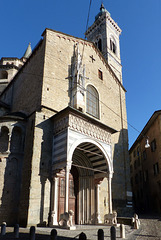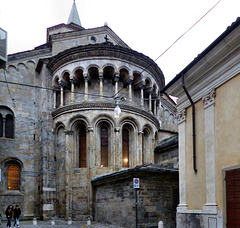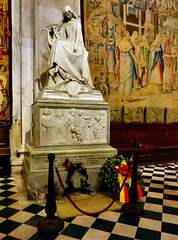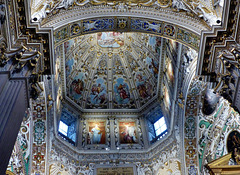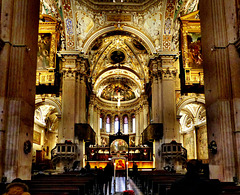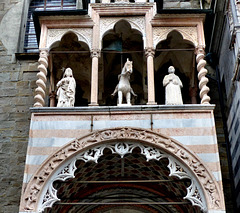Martin M. Miles' photos
Bergamo - Tempietto di Santa Croce
| |
|
|
Bergamo was the settlement of a Celtic tribe but got conquered by the Romans in 196 BC. Looted by Attila´s troops in the 5th century, it became the capital of a Lombardian duchy a century later. After the conquest of the Lombard Kingdom by Charlemagne, the Franks ruled here.
End of the 11th century Bergamo had become an independent commune, with a lot of feuding between the local the Guelph and Ghibelline factions.
In 1428 Bergamo was ceded in 1428 by the Duchy of Milan to the Republic of Venice and was transformed into a fortified city, protecting the trade routes leading into the Rhine Valley.
The French Revolutionary Army ended more than three centuries of Venetian rule in 1797. Bergamo was part of the "Cisalpine Republic".
At Congress of Vienna, Bergamo was assigned to the (Austrian) Kingdom of Lombardy–Venetia. Giuseppe Garibaldi conquered Bergamo in 1859. The city was incorporated into the newly founded Kingdom of Italy.
Bergamo´s two centres are the Città alta ("upper city"), a hilltop medieval town, and the Città bassa ("lower city").
The "Tempietto di Santa Croce" is located next to the "Basilica di Santa Maria Maggiore" erected probably in the first half of the 11th century.
It was - unfortunalety - locked.
Bergamo - Santa Maria Maggiore
| |
|
|
|
Bergamo was the settlement of a Celtic tribe but got conquered by the Romans in 196 BC. Looted by Attila´s troops in the 5th century, it became the capital of a Lombardian duchy a century later. After the conquest of the Lombard Kingdom by Charlemagne, the Franks ruled here.
End of the 11th century Bergamo had become an independent commune, with a lot of feuding between the local the Guelph and Ghibelline factions.
In 1428 Bergamo was ceded in 1428 by the Duchy of Milan to the Republic of Venice and was transformed into a fortified city, protecting the trade routes leading into the Rhine Valley.
The French Revolutionary Army ended more than three centuries of Venetian rule in 1797. Bergamo was part of the "Cisalpine Republic".
At Congress of Vienna, Bergamo was assigned to the (Austrian) Kingdom of Lombardy–Venetia. Giuseppe Garibaldi conquered Bergamo in 1859. The city was incorporated into the newly founded Kingdom of Italy.
Bergamo´s two centres are the Città alta ("upper city"), a hilltop medieval town, and the Città bassa ("lower city").
Next to the Duomo di Bergamo, opening to the Piazza Duomo, is the "Basilica di Santa Maria Maggiore".
The basilica, here seen is a detail of the frieze, that runs around the semicircular apse (see previous upload), was founded in 1137 on the site of an older church and the altar was consecrated in 1185, but during the 13th and 15th century the works slowed down and the Romanesque church never got completed.
The southern portal was just like the northern, more elaborated one created by by Giovanni da Campione ~1360. It is often called "Porta dei Leoni bianchi", while the northern is "Porta dei Leoni rossi".
The frieze may well depict portrait of Giovanni da Campione and his workshop. The Master is seated on the left, designing/sketching another piece, while to the right three stonemasons are working.
Bergamo - Santa Maria Maggiore
| |
|
Bergamo was the settlement of a Celtic tribe but got conquered by the Romans in 196 BC. Looted by Attila´s troops in the 5th century, it became the capital of a Lombardian duchy a century later. After the conquest of the Lombard Kingdom by Charlemagne, the Franks ruled here.
End of the 11th century Bergamo had become an independent commune, with a lot of feuding between the local the Guelph and Ghibelline factions.
In 1428 Bergamo was ceded in 1428 by the Duchy of Milan to the Republic of Venice and was transformed into a fortified city, protecting the trade routes leading into the Rhine Valley.
The French Revolutionary Army ended more than three centuries of Venetian rule in 1797. Bergamo was part of the "Cisalpine Republic".
At Congress of Vienna, Bergamo was assigned to the (Austrian) Kingdom of Lombardy–Venetia. Giuseppe Garibaldi conquered Bergamo in 1859. The city was incorporated into the newly founded Kingdom of Italy.
Bergamo´s two centres are the Città alta ("upper city"), a hilltop medieval town, and the Città bassa ("lower city").
Next to the Duomo di Bergamo, opening to the Piazza Duomo, is the "Basilica di Santa Maria Maggiore".
The basilica, here seen is a detail of the frieze, that runs around the semicircular apse (see previous upload), was founded in 1137 on the site of an older church and the altar was consecrated in 1185, but during the 13th and 15th century the works slowed down and the Romanesque church never got completed.
The southern portal was just like the northern, more elaborated one created by by Giovanni da Campione ~1360. It is often called "Porta dei Leoni bianchi", while the northern is "Porta dei Leoni rossi".
The front is adorned with a frieze of venerable saints.
Bergamo - Santa Maria Maggiore
| |
|
Bergamo was the settlement of a Celtic tribe but got conquered by the Romans in 196 BC. Looted by Attila´s troops in the 5th century, it became the capital of a Lombardian duchy a century later. After the conquest of the Lombard Kingdom by Charlemagne, the Franks ruled here.
End of the 11th century Bergamo had become an independent commune, with a lot of feuding between the local the Guelph and Ghibelline factions.
In 1428 Bergamo was ceded in 1428 by the Duchy of Milan to the Republic of Venice and was transformed into a fortified city, protecting the trade routes leading into the Rhine Valley.
The French Revolutionary Army ended more than three centuries of Venetian rule in 1797. Bergamo was part of the "Cisalpine Republic".
At Congress of Vienna, Bergamo was assigned to the (Austrian) Kingdom of Lombardy–Venetia. Giuseppe Garibaldi conquered Bergamo in 1859. The city was incorporated into the newly founded Kingdom of Italy.
Bergamo´s two centres are the Città alta ("upper city"), a hilltop medieval town, and the Città bassa ("lower city").
Next to the Duomo di Bergamo, opening to the Piazza Duomo, is the "Basilica di Santa Maria Maggiore".
The basilica, here seen is a detail of the frieze, that runs around the semicircular apse (see previous upload), was founded in 1137 on the site of an older church and the altar was consecrated in 1185, but during the 13th and 15th century the works slowed down and the Romanesque church never got completed.
The southern portal was just like the northern, more elaborated one created by by Giovanni da Campione ~1360. It is often called "Porta dei Leoni bianchi", while the northern is "Porta dei Leoni rossi". Seen on both portals are hunting scenes. Here is (left) a boar trying to escape a dog - and (right) a bear harvesting apples.
Bergamo - Santa Maria Maggiore
| |
|
Bergamo was the settlement of a Celtic tribe but got conquered by the Romans in 196 BC. Looted by Attila´s troops in the 5th century, it became the capital of a Lombardian duchy a century later. After the conquest of the Lombard Kingdom by Charlemagne, the Franks ruled here.
End of the 11th century Bergamo had become an independent commune, with a lot of feuding between the local the Guelph and Ghibelline factions.
In 1428 Bergamo was ceded in 1428 by the Duchy of Milan to the Republic of Venice and was transformed into a fortified city, protecting the trade routes leading into the Rhine Valley.
The French Revolutionary Army ended more than three centuries of Venetian rule in 1797. Bergamo was part of the "Cisalpine Republic".
At Congress of Vienna, Bergamo was assigned to the (Austrian) Kingdom of Lombardy–Venetia. Giuseppe Garibaldi conquered Bergamo in 1859. The city was incorporated into the newly founded Kingdom of Italy.
Bergamo´s two centres are the Città alta ("upper city"), a hilltop medieval town, and the Città bassa ("lower city").
Next to the Duomo di Bergamo, opening to the Piazza Duomo, is the "Basilica di Santa Maria Maggiore".
The basilica, here seen is a detail of the frieze, that runs around the semicircular apse (see previous upload), was founded in 1137 on the site of an older church and the altar was consecrated in 1185, but during the 13th and 15th century the works slowed down and the Romanesque church never got completed.
The southern portal was just like the northern, more elaborated one created by by Giovanni da Campione ~1360. It is often called "Porta dei Leoni bianchi", while the northern is "Porta dei Leoni rossi".
Here are the "white lions"
Bergamo - Santa Maria Maggiore
| |
|
|
Bergamo was the settlement of a Celtic tribe but got conquered by the Romans in 196 BC. Looted by Attila´s troops in the 5th century, it became the capital of a Lombardian duchy a century later. After the conquest of the Lombard Kingdom by Charlemagne, the Franks ruled here.
End of the 11th century Bergamo had become an independent commune, with a lot of feuding between the local the Guelph and Ghibelline factions.
In 1428 Bergamo was ceded in 1428 by the Duchy of Milan to the Republic of Venice and was transformed into a fortified city, protecting the trade routes leading into the Rhine Valley.
The French Revolutionary Army ended more than three centuries of Venetian rule in 1797. Bergamo was part of the "Cisalpine Republic".
At Congress of Vienna, Bergamo was assigned to the (Austrian) Kingdom of Lombardy–Venetia. Giuseppe Garibaldi conquered Bergamo in 1859. The city was incorporated into the newly founded Kingdom of Italy.
Bergamo´s two centres are the Città alta ("upper city"), a hilltop medieval town, and the Città bassa ("lower city").
Next to the Duomo di Bergamo, opening to the Piazza Duomo, is the "Basilica di Santa Maria Maggiore".
The basilica, here seen is a detail of the frieze, that runs around the semicircular apse (see previous upload), was founded in 1137 on the site of an older church and the altar was consecrated in 1185, but during the 13th and 15th century the works slowed down and the Romanesque church never got completed.
The southern portal was just like the northern, more elaborated one created by by Giovanni da Campione ~1360. It is often called "Porta dei Leoni bianchi", while the northern is "Porta dei Leoni rossi". The gothic addon above the portal was carved by Hans von Fernach between 1400 and 1403.
Bergamo - Santa Maria Maggiore
| |
|
Bergamo was the settlement of a Celtic tribe but got conquered by the Romans in 196 BC. Looted by Attila´s troops in the 5th century, it became the capital of a Lombardian duchy a century later. After the conquest of the Lombard Kingdom by Charlemagne, the Franks ruled here.
End of the 11th century Bergamo had become an independent commune, with a lot of feuding between the local the Guelph and Ghibelline factions.
In 1428 Bergamo was ceded in 1428 by the Duchy of Milan to the Republic of Venice and was transformed into a fortified city, protecting the trade routes leading into the Rhine Valley.
The French Revolutionary Army ended more than three centuries of Venetian rule in 1797. Bergamo was part of the "Cisalpine Republic".
At Congress of Vienna, Bergamo was assigned to the (Austrian) Kingdom of Lombardy–Venetia. Giuseppe Garibaldi conquered Bergamo in 1859. The city was incorporated into the newly founded Kingdom of Italy.
Bergamo´s two centres are the Città alta ("upper city"), a hilltop medieval town, and the Città bassa ("lower city").
Next to the Duomo di Bergamo, opening to the Piazza Duomo, is the "Basilica di Santa Maria Maggiore".
The basilica, here seen is a detail of the frieze, that runs around the semicircular apse (see previous upload), was founded in 1137 on the site of an older church and the altar was consecrated in 1185, but during the 13th and 15th century the works slowed down and the Romanesque church never got completed.
Bergamo - Santa Maria Maggiore
| |
|
|
Bergamo was the settlement of a Celtic tribe but got conquered by the Romans in 196 BC. Looted by Attila´s troops in the 5th century, it became the capital of a Lombardian duchy a century later. After the conquest of the Lombard Kingdom by Charlemagne, the Franks ruled here.
End of the 11th century Bergamo had become an independent commune, with a lot of feuding between the local the Guelph and Ghibelline factions.
In 1428 Bergamo was ceded in 1428 by the Duchy of Milan to the Republic of Venice and was transformed into a fortified city, protecting the trade routes leading into the Rhine Valley.
The French Revolutionary Army ended more than three centuries of Venetian rule in 1797. Bergamo was part of the "Cisalpine Republic".
At Congress of Vienna, Bergamo was assigned to the (Austrian) Kingdom of Lombardy–Venetia. Giuseppe Garibaldi conquered Bergamo in 1859. The city was incorporated into the newly founded Kingdom of Italy.
Bergamo´s two centres are the Città alta ("upper city"), a hilltop medieval town, and the Città bassa ("lower city").
Next to the Duomo di Bergamo, opening to the Piazza Duomo, is the "Basilica di Santa Maria Maggiore".
The church, here seen is the apse, was founded in 1137 on the site of aan older church and the altar was consecrated in 1185, but during the 13th and 15th century the works slowed down and the Romanesque church never got completed.
Bergamo - Santa Maria Maggiore
| |
|
|
Bergamo was the settlement of a Celtic tribe but got conquered by the Romans in 196 BC. Looted by Attila´s troops in the 5th century, it became the capital of a Lombardian duchy a century later. After the conquest of the Lombard Kingdom by Charlemagne, the Franks ruled here.
End of the 11th century Bergamo had become an independent commune, with a lot of feuding between the local the Guelph and Ghibelline factions.
In 1428 Bergamo was ceded in 1428 by the Duchy of Milan to the Republic of Venice and was transformed into a fortified city, protecting the trade routes leading into the Rhine Valley.
The French Revolutionary Army ended more than three centuries of Venetian rule in 1797. Bergamo was part of the "Cisalpine Republic".
At Congress of Vienna, Bergamo was assigned to the (Austrian) Kingdom of Lombardy–Venetia. Giuseppe Garibaldi conquered Bergamo in 1859. The city was incorporated into the newly founded Kingdom of Italy.
Bergamo´s two centres are the Città alta ("upper city"), a hilltop medieval town, and the Città bassa ("lower city").
Next to the Duomo di Bergamo, opening to the Piazza Duomo, is the "Basilica di Santa Maria Maggiore".
The church was founded in 1137 on the site of aan older church and the altar was consecrated in 1185, but during the 13th and 15th century the works slowed down and the Romanesque church never got completed.
The interior of Santa Maria Maggiore has been radically changed, compared to the original Romanesque structure, by decorations in stucco and marble from the 17th century.
The Cappella Colleoni, added to the basilica between 1472 and 1476 hosts the tombs of Bartolomeo Colleoni and his daughter Medea. But there are more tombs.
Here is a details from the sepulchre of Johann Simon Mayr (aka "Giovanni Simone Mayr") (see previous upload). Johann Simon Mayr was born in Bavaria in 1763. He was appointed "Maestro di Cappella" at the Cathedral of Bergamo and was music teacher to Gaetano Donizetti.
Bergamo - Santa Maria Maggiore
| |
|
Bergamo was the settlement of a Celtic tribe but got conquered by the Romans in 196 BC. Looted by Attila´s troops in the 5th century, it became the capital of a Lombardian duchy a century later. After the conquest of the Lombard Kingdom by Charlemagne, the Franks ruled here.
End of the 11th century Bergamo had become an independent commune, with a lot of feuding between the local the Guelph and Ghibelline factions.
In 1428 Bergamo was ceded in 1428 by the Duchy of Milan to the Republic of Venice and was transformed into a fortified city, protecting the trade routes leading into the Rhine Valley.
The French Revolutionary Army ended more than three centuries of Venetian rule in 1797. Bergamo was part of the "Cisalpine Republic".
At Congress of Vienna, Bergamo was assigned to the (Austrian) Kingdom of Lombardy–Venetia. Giuseppe Garibaldi conquered Bergamo in 1859. The city was incorporated into the newly founded Kingdom of Italy.
Bergamo´s two centres are the Città alta ("upper city"), a hilltop medieval town, and the Città bassa ("lower city").
Next to the Duomo di Bergamo, opening to the Piazza Duomo, is the "Basilica di Santa Maria Maggiore".
The church was founded in 1137 on the site of aan older church and the altar was consecrated in 1185, but during the 13th and 15th century the works slowed down and the Romanesque church never got completed.
The interior of Santa Maria Maggiore has been radically changed, compared to the original Romanesque structure, by decorations in stucco and marble from the 17th century.
The Cappella Colleoni, added to the basilica between 1472 and 1476 hosts the tombs of Bartolomeo Colleoni and his daughter Medea. But there are more tombs.
The sepulchre of Johann Simon Mayr (aka "Giovanni Simone Mayr"), born in Bavaria in 1763. He was appointed "Maestro di Cappella" at the Cathedral of Bergamo and was music teacher to Gaetano Donizetti (see previous upload).
Bergamo - Santa Maria Maggiore
| |
|
Bergamo was the settlement of a Celtic tribe but got conquered by the Romans in 196 BC. Looted by Attila´s troops in the 5th century, it became the capital of a Lombardian duchy a century later. After the conquest of the Lombard Kingdom by Charlemagne, the Franks ruled here.
End of the 11th century Bergamo had become an independent commune, with a lot of feuding between the local the Guelph and Ghibelline factions.
In 1428 Bergamo was ceded in 1428 by the Duchy of Milan to the Republic of Venice and was transformed into a fortified city, protecting the trade routes leading into the Rhine Valley.
The French Revolutionary Army ended more than three centuries of Venetian rule in 1797. Bergamo was part of the "Cisalpine Republic".
At Congress of Vienna, Bergamo was assigned to the (Austrian) Kingdom of Lombardy–Venetia. Giuseppe Garibaldi conquered Bergamo in 1859. The city was incorporated into the newly founded Kingdom of Italy.
Bergamo´s two centres are the Città alta ("upper city"), a hilltop medieval town, and the Città bassa ("lower city").
Next to the Duomo di Bergamo, opening to the Piazza Duomo, is the "Basilica di Santa Maria Maggiore".
The church was founded in 1137 on the site of aan older church and the altar was consecrated in 1185, but during the 13th and 15th century the works slowed down and the Romanesque church never got completed.
The interior of Santa Maria Maggiore has been radically changed, compared to the original Romanesque structure, by decorations in stucco and marble from the 17th century.
The Cappella Colleoni, added to the basilica between 1472 and 1476 hosts the tombs of Bartolomeo Colleoni and his daughter Medea. But there are more tombs.
The sepulchre of Gaetano Donizetti, who was born in Bergamo in 1797. Gaetano Donizetti, who composed about 70 operas, was a leading composer during the first half of the 19th century.
Bergamo - Santa Maria Maggiore
| |
|
Bergamo was the settlement of a Celtic tribe but got conquered by the Romans in 196 BC. Looted by Attila´s troops in the 5th century, it became the capital of a Lombardian duchy a century later. After the conquest of the Lombard Kingdom by Charlemagne, the Franks ruled here.
End of the 11th century Bergamo had become an independent commune, with a lot of feuding between the local the Guelph and Ghibelline factions.
In 1428 Bergamo was ceded in 1428 by the Duchy of Milan to the Republic of Venice and was transformed into a fortified city, protecting the trade routes leading into the Rhine Valley.
The French Revolutionary Army ended more than three centuries of Venetian rule in 1797. Bergamo was part of the "Cisalpine Republic".
At Congress of Vienna, Bergamo was assigned to the (Austrian) Kingdom of Lombardy–Venetia. Giuseppe Garibaldi conquered Bergamo in 1859. The city was incorporated into the newly founded Kingdom of Italy.
Bergamo´s two centres are the Città alta ("upper city"), a hilltop medieval town, and the Città bassa ("lower city").
Next to the Duomo di Bergamo, opening to the Piazza Duomo, is the "Basilica di Santa Maria Maggiore".
The church was founded in 1137 on the site of aan older church and the altar was consecrated in 1185, but during the 13th and 15th century the works slowed down and the Romanesque church never got completed.
The interior of Santa Maria Maggiore has been radically changed, compared to the original Romanesque structure, by decorations in stucco and marble from the 17th century.
The Cappella Colleoni, added to the basilica between 1472 and 1476 hosts the tombs of Bartolomeo Colleoni and his daughter Medea. But there are more tombs.
The sepulchre of Cardinale Guglielmo Longhi, who died in Avignon in 1319, was created by Ugo da Campione. The tomb was moved into the basilica, when the church it had been for centuries got demolished in the 19th century.
Bergamo - Santa Maria Maggiore
| |
|
|
|
Bergamo was the settlement of a Celtic tribe but got conquered by the Romans in 196 BC. Looted by Attila´s troops in the 5th century, it became the capital of a Lombardian duchy a century later. After the conquest of the Lombard Kingdom by Charlemagne, the Franks ruled here.
End of the 11th century Bergamo had become an independent commune, with a lot of feuding between the local the Guelph and Ghibelline factions.
In 1428 Bergamo was ceded in 1428 by the Duchy of Milan to the Republic of Venice and was transformed into a fortified city, protecting the trade routes leading into the Rhine Valley.
The French Revolutionary Army ended more than three centuries of Venetian rule in 1797. Bergamo was part of the "Cisalpine Republic".
At Congress of Vienna, Bergamo was assigned to the (Austrian) Kingdom of Lombardy–Venetia. Giuseppe Garibaldi conquered Bergamo in 1859. The city was incorporated into the newly founded Kingdom of Italy.
Bergamo´s two centres are the Città alta ("upper city"), a hilltop medieval town, and the Città bassa ("lower city").
Next to the Duomo di Bergamo, opening to the Piazza Duomo, is the "Basilica di Santa Maria Maggiore".
The church was founded in 1137 on the site of aan older church and the altar was consecrated in 1185, but during the 13th and 15th century the works slowed down and the Romanesque church never got completed.
The ornate interior of Santa Maria Maggiore. It has been radically changed compared to the original Romanesque structure, by decorations in stucco and marble from the 17th century.
Bergamo - Santa Maria Maggiore
| |
|
|
|
Bergamo was the settlement of a Celtic tribe but got conquered by the Romans in 196 BC. Looted by Attila´s troops in the 5th century, it became the capital of a Lombardian duchy a century later. After the conquest of the Lombard Kingdom by Charlemagne, the Franks ruled here.
End of the 11th century Bergamo had become an independent commune, with a lot of feuding between the local the Guelph and Ghibelline factions.
In 1428 Bergamo was ceded in 1428 by the Duchy of Milan to the Republic of Venice and was transformed into a fortified city, protecting the trade routes leading into the Rhine Valley.
The French Revolutionary Army ended more than three centuries of Venetian rule in 1797. Bergamo was part of the "Cisalpine Republic".
At Congress of Vienna, Bergamo was assigned to the (Austrian) Kingdom of Lombardy–Venetia. Giuseppe Garibaldi conquered Bergamo in 1859. The city was incorporated into the newly founded Kingdom of Italy.
Bergamo´s two centres are the Città alta ("upper city"), a hilltop medieval town, and the Città bassa ("lower city").
Next to the Duomo di Bergamo, opening to the Piazza Duomo, is the "Basilica di Santa Maria Maggiore".
The church was founded in 1137 on the site of aan older church and the altar was consecrated in 1185, but during the 13th and 15th century the works slowed down and the Romanesque church never got completed.
The ornate interior of Santa Maria Maggiore. It has been radically changed compared to the original Romanesque structure, by decorations in stucco and marble from the 17th century.
Bergamo - Santa Maria Maggiore
| |
|
Bergamo was the settlement of a Celtic tribe but got conquered by the Romans in 196 BC. Looted by Attila´s troops in the 5th century, it became the capital of a Lombardian duchy a century later. After the conquest of the Lombard Kingdom by Charlemagne, the Franks ruled here.
End of the 11th century Bergamo had become an independent commune, with a lot of feuding between the local the Guelph and Ghibelline factions.
In 1428 Bergamo was ceded in 1428 by the Duchy of Milan to the Republic of Venice and was transformed into a fortified city, protecting the trade routes leading into the Rhine Valley.
The French Revolutionary Army ended more than three centuries of Venetian rule in 1797. Bergamo was part of the "Cisalpine Republic".
At Congress of Vienna, Bergamo was assigned to the (Austrian) Kingdom of Lombardy–Venetia. Giuseppe Garibaldi conquered Bergamo in 1859. The city was incorporated into the newly founded Kingdom of Italy.
Bergamo´s two centres are the Città alta ("upper city"), a hilltop medieval town, and the Città bassa ("lower city").
Next to the Duomo di Bergamo, opening to the Piazza Duomo, is the "Basilica di Santa Maria Maggiore".
The church was founded in 1137 on the site of aan older church and the altar was consecrated in 1185, but during the 13th and 15th century the works slowed down and the Romanesque church never got completed.
Santa Maria Maggiore´s porch was created by Giovanni da Campione in 1353. He was a member of the "Maestri Campionesi" (aka "Scuola Campionese") all originating from Campione, a small Italian exclave surrounded by the Swiss canton of Ticino.
Seen here is another small detail of the porch. A shepherd - and a hunter.
Bergamo - Santa Maria Maggiore
| |
|
|
Bergamo was the settlement of a Celtic tribe but got conquered by the Romans in 196 BC. Looted by Attila´s troops in the 5th century, it became the capital of a Lombardian duchy a century later. After the conquest of the Lombard Kingdom by Charlemagne, the Franks ruled here.
End of the 11th century Bergamo had become an independent commune, with a lot of feuding between the local the Guelph and Ghibelline factions.
In 1428 Bergamo was ceded in 1428 by the Duchy of Milan to the Republic of Venice and was transformed into a fortified city, protecting the trade routes leading into the Rhine Valley.
The French Revolutionary Army ended more than three centuries of Venetian rule in 1797. Bergamo was part of the "Cisalpine Republic".
At Congress of Vienna, Bergamo was assigned to the (Austrian) Kingdom of Lombardy–Venetia. Giuseppe Garibaldi conquered Bergamo in 1859. The city was incorporated into the newly founded Kingdom of Italy.
Bergamo´s two centres are the Città alta ("upper city"), a hilltop medieval town, and the Città bassa ("lower city").
Next to the Duomo di Bergamo, opening to the Piazza Duomo, is the "Basilica di Santa Maria Maggiore".
The church was founded in 1137 on the site of aan older church and the altar was consecrated in 1185, but during the 13th and 15th century the works slowed down and the Romanesque church never got completed. Many chapels were added later.
Santa Maria Maggiore´s porch was created by Giovanni da Campione in 1353. He was a member of the "Maestri Campionesi" (aka "Scuola Campionese") all originating from Campione, a small Italian exclave surrounded by the Swiss canton of Ticino.
Seen here is a detail of the porch. Note the hunt all over the archivolt.
Bergamo - Santa Maria Maggiore / Cappella Colleoni
| |
|
Bergamo was the settlement of a Celtic tribe but got conquered by the Romans in 196 BC. Looted by Attila´s troops in the 5th century, it became the capital of a Lombardian duchy a century later. After the conquest of the Lombard Kingdom by Charlemagne, the Franks ruled here.
End of the 11th century Bergamo had become an independent commune, with a lot of feuding between the local the Guelph and Ghibelline factions.
In 1428 Bergamo was ceded in 1428 by the Duchy of Milan to the Republic of Venice and was transformed into a fortified city, protecting the trade routes leading into the Rhine Valley.
The French Revolutionary Army ended more than three centuries of Venetian rule in 1797. Bergamo was part of the "Cisalpine Republic".
At Congress of Vienna, Bergamo was assigned to the (Austrian) Kingdom of Lombardy–Venetia. Giuseppe Garibaldi conquered Bergamo in 1859. The city was incorporated into the newly founded Kingdom of Italy.
Bergamo´s two centres are the Città alta ("upper city"), a hilltop medieval town, and the Città bassa ("lower city").
Next to the Duomo di Bergamo, opening to the Piazza Duomo, is the "Basilica di Santa Maria Maggiore".
The church was founded in 1137 on the site of aan older church and the altar was consecrated in 1185, but during the 13th and 15th century the works slowed down and the Romanesque church never got completed. Many chapels were added later.
Here is Santa Maria Maggiore´s porch, created by Giovanni da Campione in 1353, who as well built the nearby baptistery. He was a member of the "Maestri Campionesi" (aka "Scuola Campionese") all originating from Campione, a small Italian exclave surrounded by the Swiss canton of Ticino.
Bergamo - Santa Maria Maggiore / Cappella Colleoni
| |
|
Bergamo was the settlement of a Celtic tribe but got conquered by the Romans in 196 BC. Looted by Attila´s troops in the 5th century, it became the capital of a Lombardian duchy a century later. After the conquest of the Lombard Kingdom by Charlemagne, the Franks ruled here.
End of the 11th century Bergamo had become an independent commune, with a lot of feuding between the local the Guelph and Ghibelline factions.
In 1428 Bergamo was ceded in 1428 by the Duchy of Milan to the Republic of Venice and was transformed into a fortified city, protecting the trade routes leading into the Rhine Valley.
The French Revolutionary Army ended more than three centuries of Venetian rule in 1797. Bergamo was part of the "Cisalpine Republic".
At Congress of Vienna, Bergamo was assigned to the (Austrian) Kingdom of Lombardy–Venetia. Giuseppe Garibaldi conquered Bergamo in 1859. The city was incorporated into the newly founded Kingdom of Italy.
Bergamo´s two centres are the Città alta ("upper city"), a hilltop medieval town, and the Città bassa ("lower city").
Next to the Duomo di Bergamo, opening to the Piazza Duomo, is the "Basilica di Santa Maria Maggiore".
The church was founded in 1137 on the site of aan older church and the altar was consecrated in 1185, but during the 13th and 15th century the works slowed down and the Romanesque church never got completed. Many chapels were added later. Here (left) is Santa Maria Maggiore´s porch, created by Giovanni da Campione in 1353.
To the right is the Cappella Colleoni, built (1472 - 1476) for Bartolomeo Colleoni, captain-general of the Republic of Venice. He had a sacristy teared down and commisioned Giovanni Antonio Amadeo to design this mausoleum, the Cappella Colleoni, for him and his beloved daughter Medea, who died 1470 at the age of 15.
Bartolomeo Colleoni is not only remembered for this elaborate mausolem, but as well for his coat of arms, representing three human testes on the shield.
Jump to top
- ipernity © 2007-2024
- Help & Contact
|
Club news
|
About ipernity
|
History |
ipernity Club & Prices |
Guide of good conduct
Donate | Group guidelines | Privacy policy | Terms of use | Statutes | In memoria -
Facebook
Twitter





